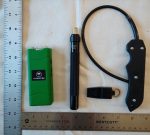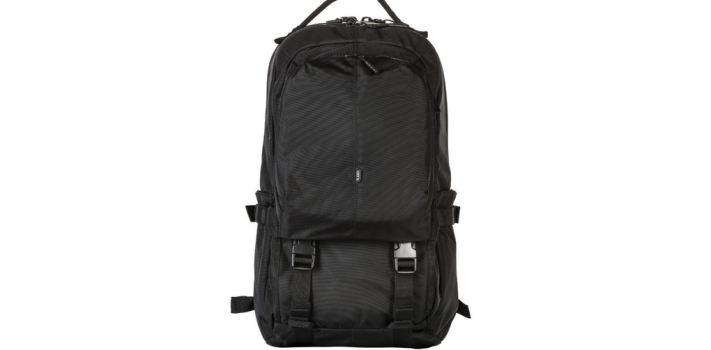(Continued From Part 3.)
Information/References
I firmly believe that one of the keys to surviving almost any situation is having the right information, so I tried to include enough of the right information sources to get her through her journey. Fortunately, she has a decent cell phone in a rugged case, so she can use that in most scenarios. Here’s what I recommended:
- Rand McNally maps (2.5 oz./ea., 5.0 oz. per trip) – These are hardcopy state-level plastic coated maps. They’re not as detailed as topo or Delorme Atlas and Gazetter maps, but they’re a lot lighter and more compact and adequate for generally finding her way home. Connecticut and Rhode Island are on one map, Vermont and New Hampshire are on one, so with Massachusetts and Maine she only needs to buy four maps in all, and she only needs to carry the ones for where she’s travelling. Typically she’ll only need 2 maps to cover her route home, so that’s 5 oz. total.
- Clip-On Wrist Compass (1 oz.) – It’s not a full blown military compass, but it works well and it’s a lot lighter and more compact. Another good alternative is the Brunton Classic Tag-A-Long Plus Compass.
- Open Street Maps (0 oz.) – I had her install this on her phone and download all of the detailed New England state maps. Even if GPS is out it can still provide her access to some pretty detailed topographic and landmark maps.
- Trip plan (1.0 oz.) – I created an example of a trip plan and had her create one for each of her customer locations. It’s an 11”x14” color map printout with one side centered around the customer site that shows locations for the closest grocery stores, convenience stores, bike shops, gun shops, camping supply stores, etc., and the other side showing potential supply sources and locations of interest along her possible routes home. The paper is pre-folded and then coated with Aquaseal If electronics aren’t available this can provide her with possible locations to stock up on additional food supplies or purchase a bicycle, snowshoes, etc. to reduce her trip time.
- Scanner Radio Pro (0 oz.) – This is an app for her cell phone that provides access to some local LE and other emergency radio traffic. I desperately wanted to justify including a handheld scanner radio that handles trunked comms in her backpack, since many New England LE and emergency services have switched to trunked, but the only options available are the Uniden Bearcat BCD325P2/BCD436HP or Whistler TRX-1 which are pretty bulky and heavy (> 8 oz. w/batteries). I ended up having her buy a Uniden BCD325P2 to carry in her suitcase on overnight trips, and I pre-programmed it using FreeScan with the frequencies for all potentially relevant groups, agencies, departments, etc. between her home and the various areas she visits. I had her install some rechargeable AA batteries and included a USB-C to Mini USB adapter so the batteries could be recharged right in the radio. I also had her include a mono earphone so she could listen to the radio without attracting attention, and I created a little half-page cheat sheet that shows her how to run the pre-programmed scans, select and run band scans, tune into specific frequencies, etc.
- Survival/First Aid guides (1.1 oz.) – These are actually pretty useful and should help fill in any gaps in her knowledge/training.
Total weight for the bits going into her backpack is 5.6 oz., bringing the grand total up to 11 lbs. (174.65 oz.) I also suggested that she take a local land navigation training course to get comfortable with using maps and a compass.
Self-Defense
It doesn’t have to be the end of the world for bad things to happen, and given that she’s usually traveling alone there’s a good chance that she’ll need to be able to defend herself at some point. She and her husband are comfortable with firearms and are both licensed to carry, but all of her customer sites have strict no firearms policies and she doesn’t want to risk her job so I came up with a couple of alternatives she can add to her kit:
- ASP Key Defender pepper spray (2 oz.) – This is a nice-sized pepper spray unit with replaceable inserts that fits into a pen pocket. I made it clear that she should always have this on her person, not in her backpack.
- Fast Strike FS-14 (2.9 oz.) – This is a pretty lightweight but hard-hitting flexible strike weapon. I showed her how to attach it to the inside of her backpack shoulder strap for fast access.
- VIPERTEK VTS-881 Micro Stun Gun (3.2 oz.) – A compact but powerful stun gun. I attached a small clip to it so she could carry it clipped inside her pants or jacket pocket for easy access.
- Acme Tornado Slimline Whistle 636 (.1 oz.) – This is an ultralight and super loud (117db) whistle that I recommend she wear on a dog tag chain around her neck. Useful for summoning help in an emergency rescue scenario or an attack.
 None of these are as effective as a firearm, but they’re all things she can legally carry pretty much anywhere in New England, including most of her customer’s facilities. Since the only item that’s in (or on in this case) the backpack is the Fast Strike, that adds 2.9 oz., updating to total backpack weight to 11.1 lbs. (177.55 oz.) I spent some time going over examples of ad-hoc weapons like rocks, pipes, clubs, sand (for throwing in an attacker’s face), kitchen knives and sharpened sticks, and also recommended that she take some self-defense training.
None of these are as effective as a firearm, but they’re all things she can legally carry pretty much anywhere in New England, including most of her customer’s facilities. Since the only item that’s in (or on in this case) the backpack is the Fast Strike, that adds 2.9 oz., updating to total backpack weight to 11.1 lbs. (177.55 oz.) I spent some time going over examples of ad-hoc weapons like rocks, pipes, clubs, sand (for throwing in an attacker’s face), kitchen knives and sharpened sticks, and also recommended that she take some self-defense training.
Clothing
I’m going to cover seasonal stuff shortly, but there are a couple of clothing items I recommended she carry no matter what the season:
- Spare socks (2.1 oz.) – Keeping your feet warm and healthy is critical if you’re going to be walking a long ways, and I always recommend merino wool socks regardless of the season. The quoted weight is for a pair of medium weight Smartwool hiking socks.
- Sun Tripper Cap (2.5 oz.) – Keeping the sun, snow and rain out of your eyes and off your glasses makes seeing where you’re going a lot easier, and this lightweight hat folds up into a nice small package. I recommended that she regularly spray it (at least the brim) with waterproofing spray. It’s also SPF 50 rated, so it’ll help keep the hot sun off of her head on those rare blazing hot summer days.
- Vertice Rain Pants (2.9 oz.) – Keeping dry is critical to staying warm, and since the poncho will only cover her down to around her knees these provide the difference in coverage. They work equally well in deep snow in winter and are breathable, with the addition of a couple of strong rubber bands around the ankles to keep the snow out. I have an extra pair of adjustable stretch bands I made from 3/32” shock cord and small cord locks that I gave her that work well for this.
- Bandana (.1 oz) – A standard bandana is one of those items that has dozens of different uses, from covering her face to pre-filtering water to a handkerchief.
These three items add 7.6 oz., making the new total 11.6 lbs. (185.15 oz.). This is the final ‘base’ weight of her GHB kit with the backpack but without season-specific and work gear. If the work laptop and tools are added back in (2.5 lbs.) that makes it 14.1 lbs., which is less than a third of the generally recognized acceptable maximum weight for a backpack and below the more common ‘10% of your body weight’ for a daily carry pack. I had her carry it around for a few days at work and on a couple of hikes, and she was found the weight acceptable.
(To be concluded, in Part 5.)










